turbo LAND ROVER DISCOVERY 2002 User Guide
[x] Cancel search | Manufacturer: LAND ROVER, Model Year: 2002, Model line: DISCOVERY, Model: LAND ROVER DISCOVERY 2002Pages: 1672, PDF Size: 46.1 MB
Page 178 of 1672
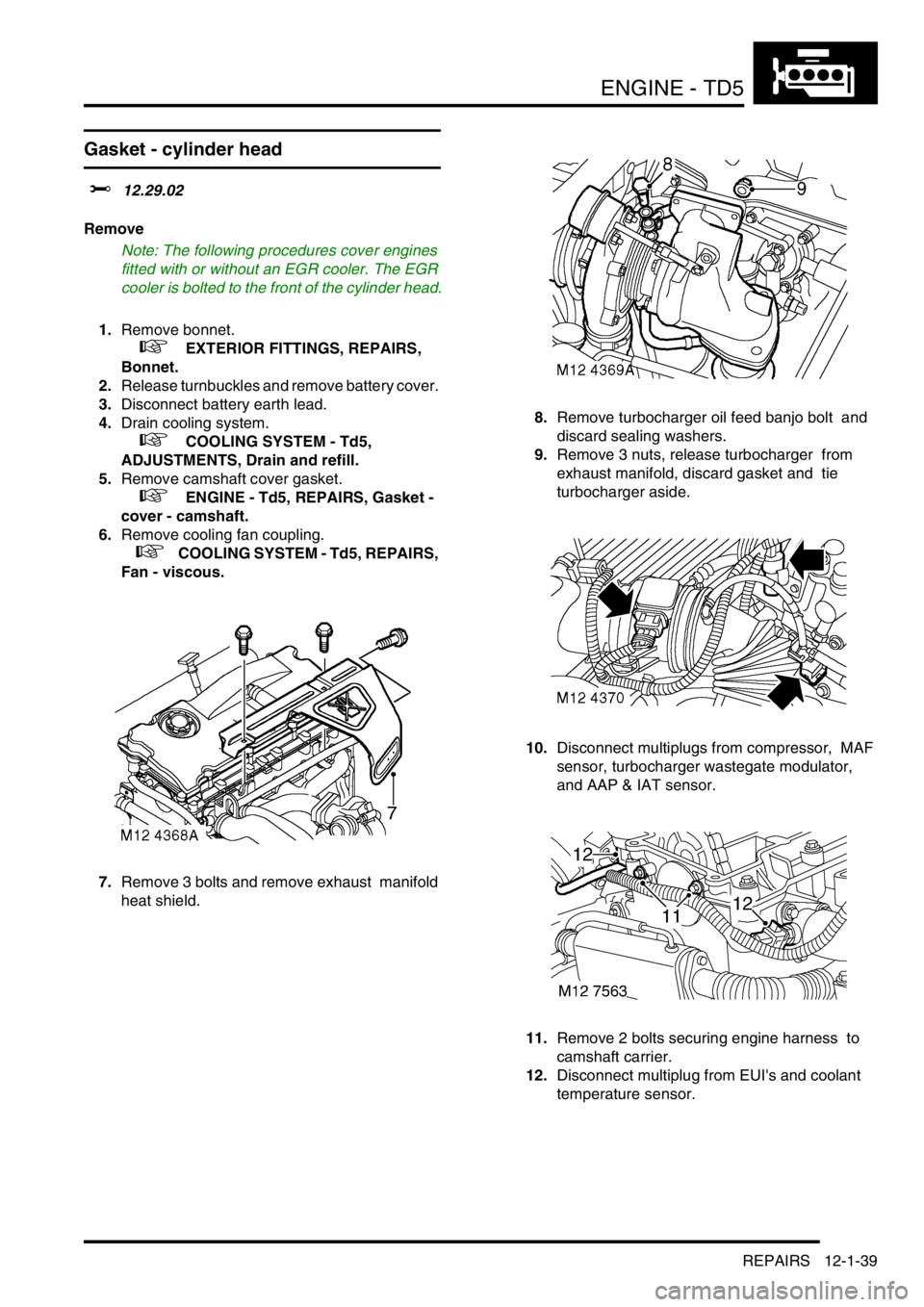
ENGINE - TD5
REPAIRS 12-1-39
Gasket - cylinder head
$% 12.29.02
Remove
Note: The following procedures cover engines
fitted with or without an EGR cooler. The EGR
cooler is bolted to the front of the cylinder head.
1.Remove bonnet.
+ EXTERIOR FITTINGS, REPAIRS,
Bonnet.
2.Release turnbuckles and remove battery cover.
3.Disconnect battery earth lead.
4.Drain cooling system.
+ COOLING SYSTEM - Td5,
ADJUSTMENTS, Drain and refill.
5.Remove camshaft cover gasket.
+ ENGINE - Td5, REPAIRS, Gasket -
cover - camshaft.
6.Remove cooling fan coupling.
+ COOLING SYSTEM - Td5, REPAIRS,
Fan - viscous.
7.Remove 3 bolts and remove exhaust manifold
heat shield. 8.Remove turbocharger oil feed banjo bolt and
discard sealing washers.
9.Remove 3 nuts, release turbocharger from
exhaust manifold, discard gasket and tie
turbocharger aside.
10.Disconnect multiplugs from compressor, MAF
sensor, turbocharger wastegate modulator,
and AAP & IAT sensor.
11.Remove 2 bolts securing engine harness to
camshaft carrier.
12.Disconnect multiplug from EUI's and coolant
temperature sensor.
Page 182 of 1672

ENGINE - TD5
REPAIRS 12-1-43
11.Clean camshaft sprocket and mating face on
camshaft.
12.Ensure engine is set to TDC No. 1 cylinder and
mark on camshaft sprocket is positioned
between the 2 coloured links.
13.Position camshaft sprocket to camshaft; fit and
lightly tighten new bolts, then loosen bolts half
a turn.
14.Clean timing chain fixed guide retaining pin and
apply Loctite 242 to threads.
15.Fit timing chain fixed guide retaining pin and
tighten to 25 Nm (18 lbf.ft) .
16.Clean timing chain tensioner and fit new
sealing washer.
17.Fit timing chain tensioner and tighten to 45 Nm
(22 lbf.ft).
18.Tighten bolts securing camshaft sprocket to
camshaft to 37 Nm (27 lbf.ft).
19.Remove tool LRT-12-058 from camshaft.
20.Remove tool LRT-12-158 from gearbox bell
housing.
21.Fit new camshaft bore blanking plug and 'O'-
ring seal in recess in cylinder head.
22.Clean vacuum pump union.
23.Tighten union securing vacuum pump oil feed
pipe to cylinder head to 10 Nm (7 lbf.ft) .
24.Fit bolts securing alternator support bracket to
cylinder head and tighten to 25 Nm (18 lbf.ft) .
25.Connect top hose and heater hoses and secure
with clips.
26. Pre EU3 model:Fit bolt securing EGR pipe
clamp to cylinder head bolt and tighten to 10
Nm (7 lbf.ft) .
27. EU3 model: Connect coolant hoses to EGR
cooler and secure with the clips.
28.Position air intake hose to EGR valve and
tighten clip screw.
29.Disconnect fuel hose from connector block and
connect to fuel cooler.
30.Connect fuel hoses to fuel cooler and
connector block on cylinder head.
31.Connect coolant hoses to fuel cooler and
secure clips.
32.Connect vacuum hose to EGR valve.
33.Position engine harness and connect multi
plugs and glow plug connectors.
34.Fit and tighten bolts, engine harness to
camshaft carrier.
35.Clean exhaust manifold and turbocharger
interface.
36.Fit new gasket to exhaust manifold, position
turbocharger and tighten – nuts securing
turbocharger to manifold to 30 Nm (22 lbf.ft).
37.Clean turbocharger oil feed hose bolt.
38.Position turbocharger oil feed hose using new
sealing washers. Fit banjo bolt securing
turbocharger oil feed hose and tighten to 25 Nm
(18 lbf.ft) . 39.Position exhaust manifold heatshield and
tighten M6 bolts to 9 Nm (7 lbf.ft) and M8 bolt to
25 Nm (18 lbf.ft).
40.Fit cooling fan coupling.
+ COOLING SYSTEM - Td5, REPAIRS,
Fan - viscous.
41.Fit camshaft cover with new seal.
+ ENGINE - Td5, REPAIRS, Gasket -
cover - camshaft.
42.Refill cooling system.
+ COOLING SYSTEM - Td5,
ADJUSTMENTS, Drain and refill.
43.Connect battery earth lead.
44.Fit battery cover and secure fixings.
45.Fit bonnet.
+ EXTERIOR FITTINGS, REPAIRS,
Bonnet.
Page 186 of 1672
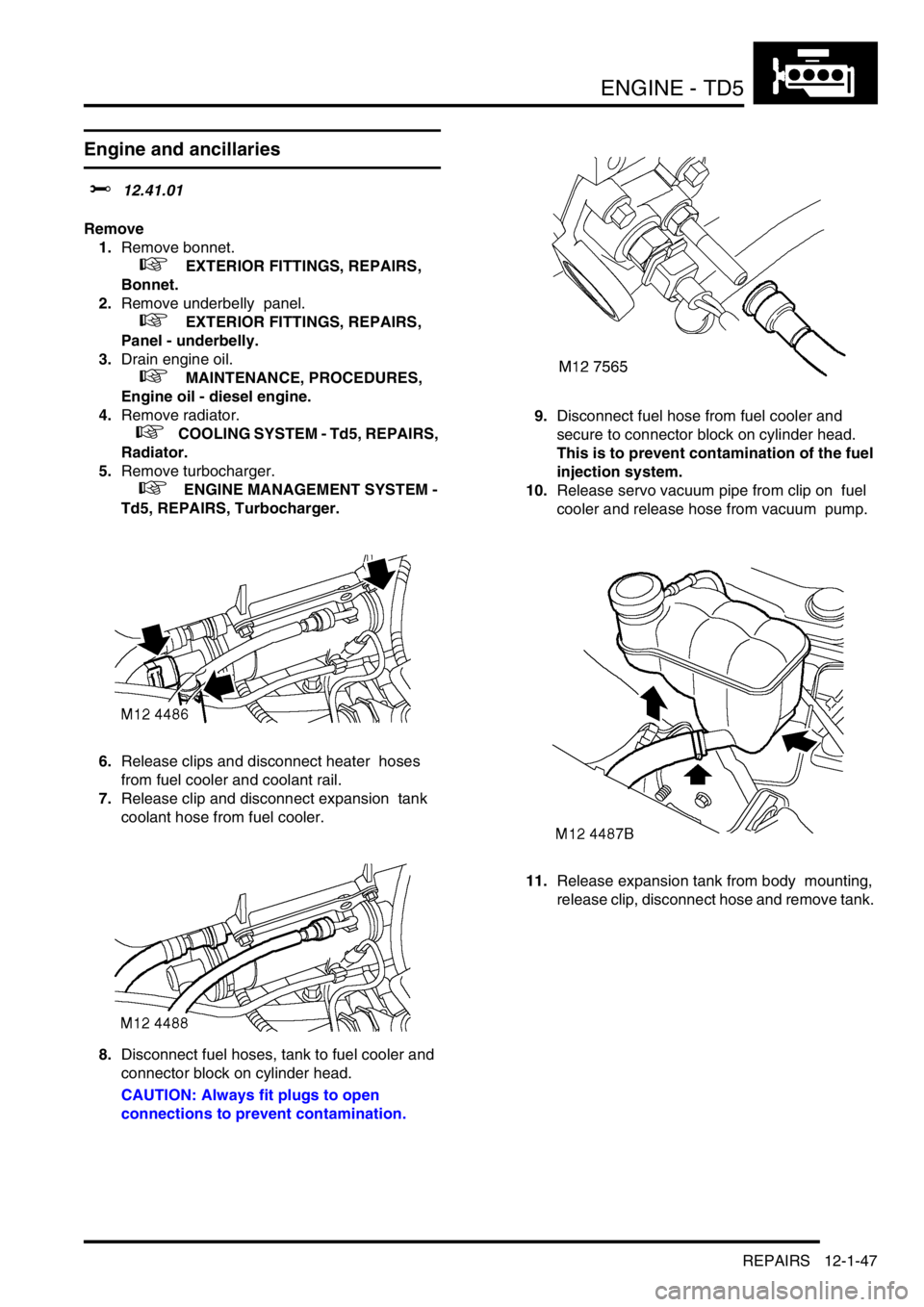
ENGINE - TD5
REPAIRS 12-1-47
Engine and ancillaries
$% 12.41.01
Remove
1.Remove bonnet.
+ EXTERIOR FITTINGS, REPAIRS,
Bonnet.
2.Remove underbelly panel.
+ EXTERIOR FITTINGS, REPAIRS,
Panel - underbelly.
3.Drain engine oil.
+ MAINTENANCE, PROCEDURES,
Engine oil - diesel engine.
4.Remove radiator.
+ COOLING SYSTEM - Td5, REPAIRS,
Radiator.
5.Remove turbocharger.
+ ENGINE MANAGEMENT SYSTEM -
Td5, REPAIRS, Turbocharger.
6.Release clips and disconnect heater hoses
from fuel cooler and coolant rail.
7.Release clip and disconnect expansion tank
coolant hose from fuel cooler.
8.Disconnect fuel hoses, tank to fuel cooler and
connector block on cylinder head.
CAUTION: Always fit plugs to open
connections to prevent contamination.9.Disconnect fuel hose from fuel cooler and
secure to connector block on cylinder head.
This is to prevent contamination of the fuel
injection system.
10.Release servo vacuum pipe from clip on fuel
cooler and release hose from vacuum pump.
11.Release expansion tank from body mounting,
release clip, disconnect hose and remove tank.
Page 188 of 1672
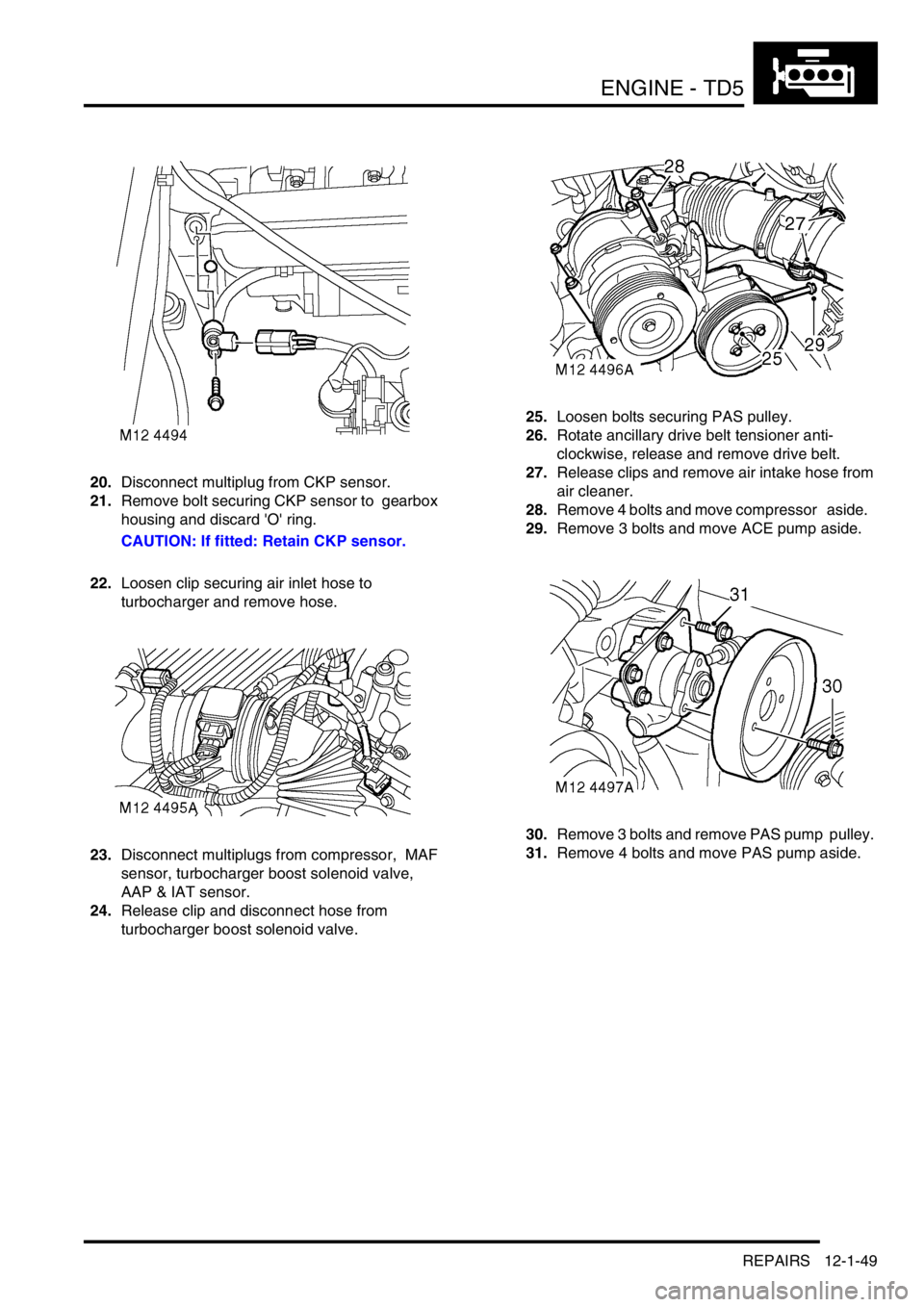
ENGINE - TD5
REPAIRS 12-1-49
20.Disconnect multiplug from CKP sensor.
21.Remove bolt securing CKP sensor to gearbox
housing and discard 'O' ring.
CAUTION: If fitted: Retain CKP sensor.
22.Loosen clip securing air inlet hose to
turbocharger and remove hose.
23.Disconnect multiplugs from compressor, MAF
sensor, turbocharger boost solenoid valve,
AAP & IAT sensor.
24.Release clip and disconnect hose from
turbocharger boost solenoid valve. 25.Loosen bolts securing PAS pulley.
26.Rotate ancillary drive belt tensioner anti-
clockwise, release and remove drive belt.
27.Release clips and remove air intake hose from
air cleaner.
28.Remove 4 bolts and move compressor aside.
29.Remove 3 bolts and move ACE pump aside.
30.Remove 3 bolts and remove PAS pump pulley.
31.Remove 4 bolts and move PAS pump aside.
Page 191 of 1672
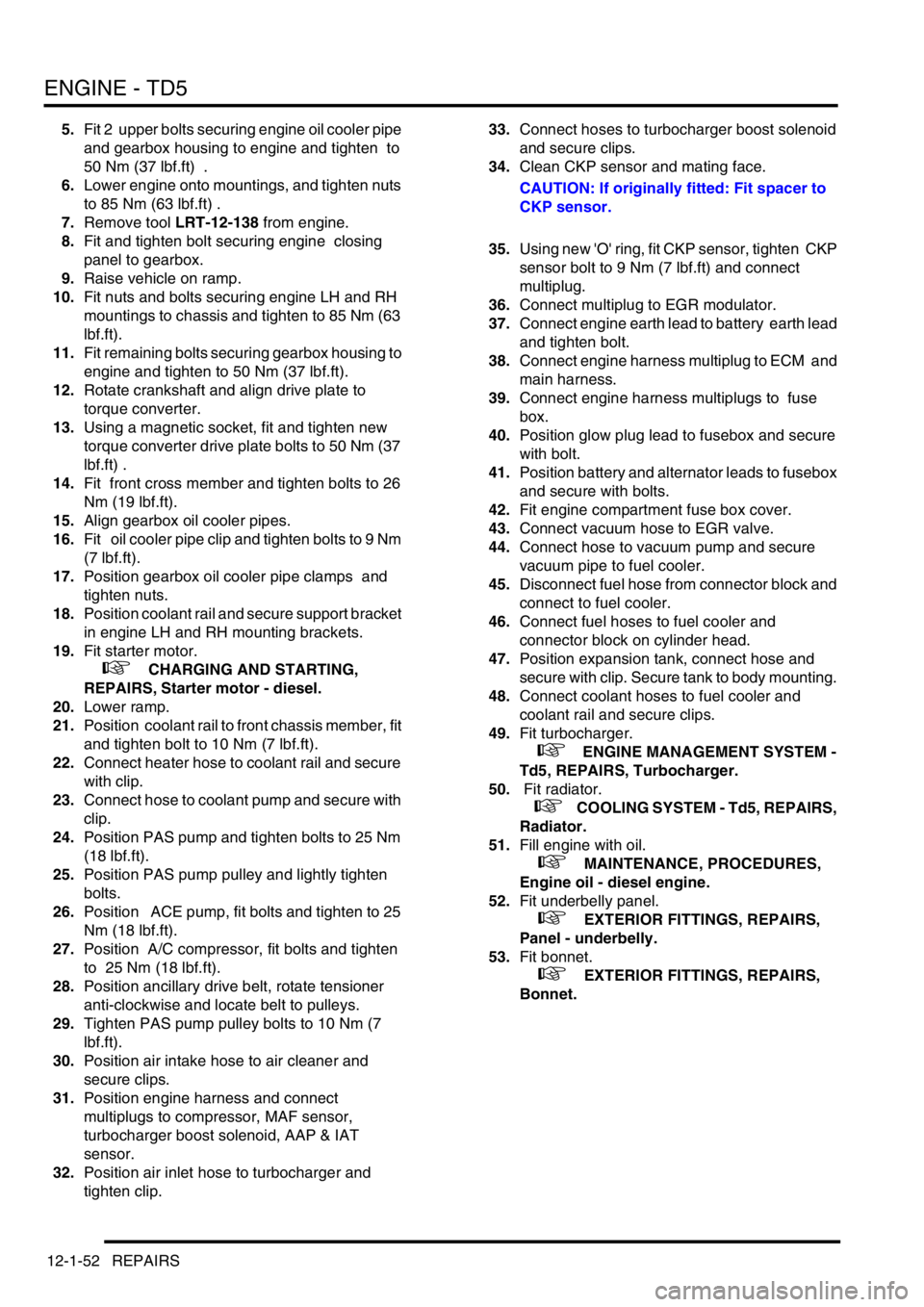
ENGINE - TD5
12-1-52 REPAIRS
5.Fit 2 upper bolts securing engine oil cooler pipe
and gearbox housing to engine and tighten to
50 Nm (37 lbf.ft) .
6.Lower engine onto mountings, and tighten nuts
to 85 Nm (63 lbf.ft) .
7.Remove tool LRT-12-138 from engine.
8.Fit and tighten bolt securing engine closing
panel to gearbox.
9.Raise vehicle on ramp.
10.Fit nuts and bolts securing engine LH and RH
mountings to chassis and tighten to 85 Nm (63
lbf.ft).
11.Fit remaining bolts securing gearbox housing to
engine and tighten to 50 Nm (37 lbf.ft).
12.Rotate crankshaft and align drive plate to
torque converter.
13.Using a magnetic socket, fit and tighten new
torque converter drive plate bolts to 50 Nm (37
lbf.ft) .
14.Fit front cross member and tighten bolts to 26
Nm (19 lbf.ft).
15.Align gearbox oil cooler pipes.
16.Fit oil cooler pipe clip and tighten bolts to 9 Nm
(7 lbf.ft).
17.Position gearbox oil cooler pipe clamps and
tighten nuts.
18.Position coolant rail and secure support bracket
in engine LH and RH mounting brackets.
19.Fit starter motor.
+ CHARGING AND STARTING,
REPAIRS, Starter motor - diesel.
20.Lower ramp.
21.Position coolant rail to front chassis member, fit
and tighten bolt to 10 Nm (7 lbf.ft).
22.Connect heater hose to coolant rail and secure
with clip.
23.Connect hose to coolant pump and secure with
clip.
24.Position PAS pump and tighten bolts to 25 Nm
(18 lbf.ft).
25.Position PAS pump pulley and lightly tighten
bolts.
26.Position ACE pump, fit bolts and tighten to 25
Nm (18 lbf.ft).
27.Position A/C compressor, fit bolts and tighten
to 25 Nm (18 lbf.ft).
28.Position ancillary drive belt, rotate tensioner
anti-clockwise and locate belt to pulleys.
29.Tighten PAS pump pulley bolts to 10 Nm (7
lbf.ft).
30.Position air intake hose to air cleaner and
secure clips.
31.Position engine harness and connect
multiplugs to compressor, MAF sensor,
turbocharger boost solenoid, AAP & IAT
sensor.
32.Position air inlet hose to turbocharger and
tighten clip. 33.Connect hoses to turbocharger boost solenoid
and secure clips.
34.Clean CKP sensor and mating face.
CAUTION: If originally fitted: Fit spacer to
CKP sensor.
35.Using new 'O' ring, fit CKP sensor, tighten CKP
sensor bolt to 9 Nm (7 lbf.ft) and connect
multiplug.
36.Connect multiplug to EGR modulator.
37.Connect engine earth lead to battery earth lead
and tighten bolt.
38.Connect engine harness multiplug to ECM and
main harness.
39.Connect engine harness multiplugs to fuse
box.
40.Position glow plug lead to fusebox and secure
with bolt.
41.Position battery and alternator leads to fusebox
and secure with bolts.
42.Fit engine compartment fuse box cover.
43.Connect vacuum hose to EGR valve.
44.Connect hose to vacuum pump and secure
vacuum pipe to fuel cooler.
45.Disconnect fuel hose from connector block and
connect to fuel cooler.
46.Connect fuel hoses to fuel cooler and
connector block on cylinder head.
47.Position expansion tank, connect hose and
secure with clip. Secure tank to body mounting.
48.Connect coolant hoses to fuel cooler and
coolant rail and secure clips.
49.Fit turbocharger.
+ ENGINE MANAGEMENT SYSTEM -
Td5, REPAIRS, Turbocharger.
50. Fit radiator.
+ COOLING SYSTEM - Td5, REPAIRS,
Radiator.
51.Fill engine with oil.
+ MAINTENANCE, PROCEDURES,
Engine oil - diesel engine.
52.Fit underbelly panel.
+ EXTERIOR FITTINGS, REPAIRS,
Panel - underbelly.
53.Fit bonnet.
+ EXTERIOR FITTINGS, REPAIRS,
Bonnet.
Page 203 of 1672

ENGINE - TD5
12-1-64 REPAIRS
Refit
1.Clean oil cooler and mating faces.
2.Fit oil pressure switch and tighten to 9 Nm (7
lbf.ft).
3.Position new gasket and fit oil cooler housing,
tighten bolts to 25 Nm (18 lbf.ft).
4.Position and fit oil filter adaptor housing,
tighten bolts to 25 Nm (18 lbf. ft).
5.Fit oil filter, tighten hand tight then a further half
turn.
6.Position coolant hose to oil cooler and secure
clip.
7.Position coolant pipe bolt and tighten to 50 Nm
(37 lbf.ft) .
8.Connect multiplug to oil pressure switch.
9.Fit centrifuge assembly.
+ ENGINE - Td5, REPAIRS, Gasket -
centrifuge oil drain pipe.
10.Refill cooling system.
+ COOLING SYSTEM - Td5,
ADJUSTMENTS, Drain and refill.
11.Top up engine oil.
+ MAINTENANCE, PROCEDURES,
Engine oil - diesel engine.
Gasket - centrifuge oil drain pipe
$% 12.60.90
Remove
1.Raise front of vehicle.
WARNING: Do not work on or under a
vehicle supported only by a jack. Always
support the vehicle on safety stands.
2.Remove fixings and remove underbelly panel.
3.Remove 2 bolts securing centrifuge drain to
engine sump and discard gasket. (Some
models are fitted with studs and nuts,
others with bolts).
4.Remove turbocharger.
+ ENGINE MANAGEMENT SYSTEM -
Td5, REPAIRS, Turbocharger.
5. Models with air conditioning: Remove
auxiliary drive belt.
+ CHARGING AND STARTING,
REPAIRS, Belt - auxiliary drive.
6. Models with air conditioning: Remove 4 bolts
securing compressor and move to one side.
Page 204 of 1672

ENGINE - TD5
REPAIRS 12-1-65
7.Remove 3 bolts securing centrifuge to engine
oil cooler.
8.Remove centrifuge and discard 'O' ring.
9.Remove 2 bolts, remove drain pipe from
centrifuge and discard gasket. Refit
1.Clean mating faces of centrifuge, oil cooler and
sump.
2.Position new gasket and fit oil drain pipe to
centrifuge, tighten bolts to 10 Nm (7 lbf.ft).
CAUTION: Gasket must be fitted dry.
3.Position new 'O' ring to oil cooler.
4.Position centrifuge to oil cooler housing and
tighten bolts to 25 Nm (18 lbf.ft).
5.Using a new gasket, align the centrifuge oil
drain pipe to sump and tighten bolts to 10 Nm
(7 lbf.ft).
CAUTION: Gasket must be fitted dry.
6. Models with air conditioning: Position A/C
compressor and tighten bolts to 25 Nm (18
lbf.ft).
7.Fit turbocharger.
+ ENGINE MANAGEMENT SYSTEM -
Td5, REPAIRS, Turbocharger.
8. Models with air conditioning: Fit auxiliary
drive belt.
+ CHARGING AND STARTING,
REPAIRS, Belt - auxiliary drive.
9.Fit underbelly panel and secure with fixings.
10.Remove stand(s) and lower vehicle.
Page 209 of 1672
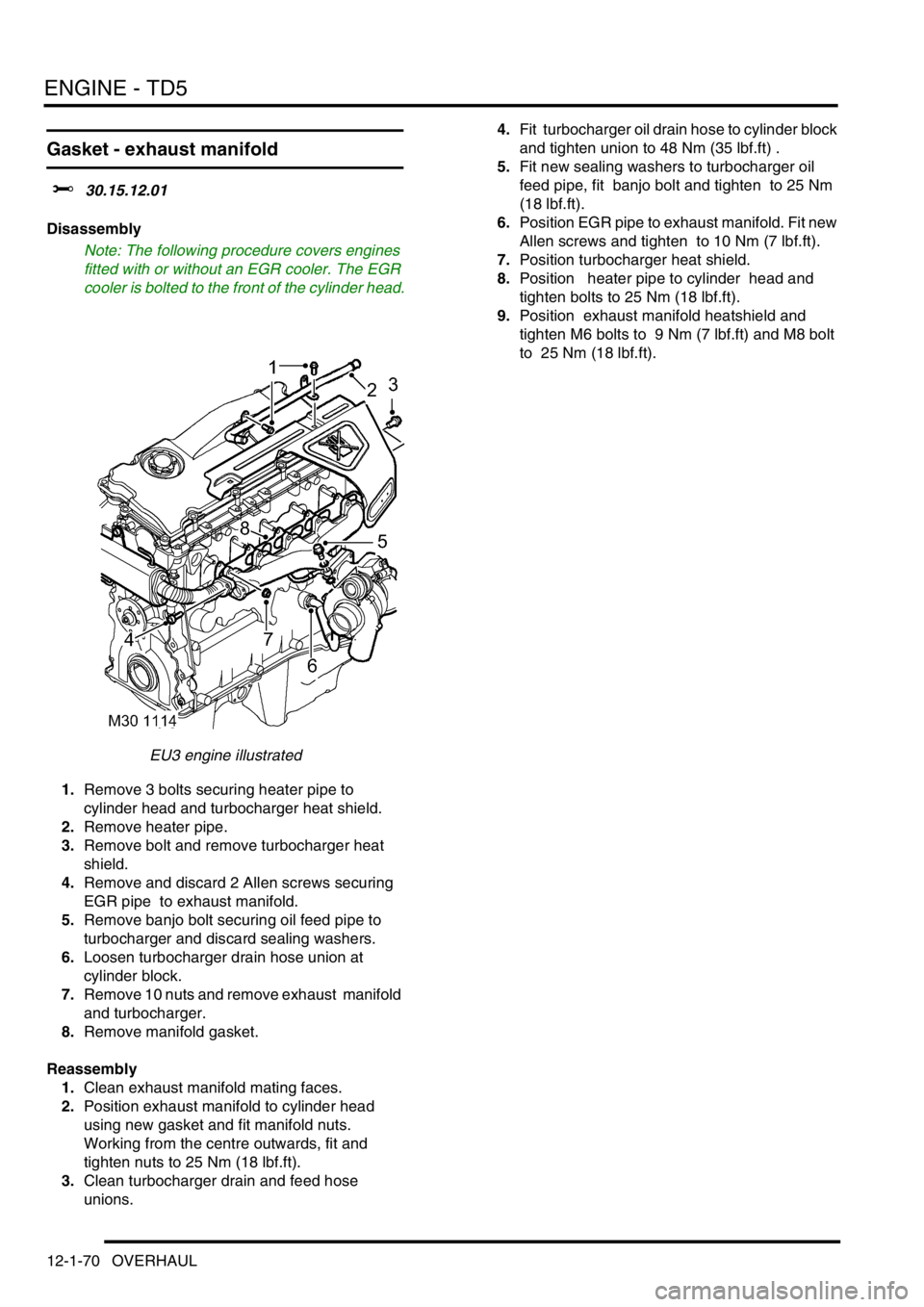
ENGINE - TD5
12-1-70 OVERHAUL
Gasket - exhaust manifold
$% 30.15.12.01
Disassembly
Note: The following procedure covers engines
fitted with or without an EGR cooler. The EGR
cooler is bolted to the front of the cylinder head.
EU3 engine illustrated
1.Remove 3 bolts securing heater pipe to
cylinder head and turbocharger heat shield.
2.Remove heater pipe.
3.Remove bolt and remove turbocharger heat
shield.
4.Remove and discard 2 Allen screws securing
EGR pipe to exhaust manifold.
5.Remove banjo bolt securing oil feed pipe to
turbocharger and discard sealing washers.
6.Loosen turbocharger drain hose union at
cylinder block.
7.Remove 10 nuts and remove exhaust manifold
and turbocharger.
8.Remove manifold gasket.
Reassembly
1.Clean exhaust manifold mating faces.
2.Position exhaust manifold to cylinder head
using new gasket and fit manifold nuts.
Working from the centre outwards, fit and
tighten nuts to 25 Nm (18 lbf.ft).
3.Clean turbocharger drain and feed hose
unions. 4.Fit turbocharger oil drain hose to cylinder block
and tighten union to 48 Nm (35 lbf.ft) .
5.Fit new sealing washers to turbocharger oil
feed pipe, fit banjo bolt and tighten to 25 Nm
(18 lbf.ft).
6.Position EGR pipe to exhaust manifold. Fit new
Allen screws and tighten to 10 Nm (7 lbf.ft).
7.Position turbocharger heat shield.
8.Position heater pipe to cylinder head and
tighten bolts to 25 Nm (18 lbf.ft).
9.Position exhaust manifold heatshield and
tighten M6 bolts to 9 Nm (7 lbf.ft) and M8 bolt
to 25 Nm (18 lbf.ft).
Page 325 of 1672

EMISSION CONTROL - TD5
17-1-4 DESCRIPTION AND OPERATION
Emission Control Systems
Engine design has evolved in order to minimise the emission of harmful by-products. Emission control systems fitted
to Land Rover vehicles are designed to maintain the emission levels within the legal limits pertaining for the specified
market.
Despite the utilisation of specialised emission control equipment, it is still necessary to ensure that the engine is
correctly maintained and is in good mechanical order, so that it operates at its optimum condition.
In addition to emissions improvements through engine design and the application of electronic engine management
systems, special emission control systems are used to limit the pollutant levels developed under certain conditions.
Two main types of additional emission control system are utilised with the Td5 engine to reduce the levels of harmful
emissions released into the atmosphere. These are as follows:
1Crankcase emission control – also known as blow-by gas emissions from the engine crankcase.
2Exhaust gas recirculation – to reduce NO
2 emissions.
Crankcase emission control
All internal combustion engines generate oil vapour and smoke in the crankcase as a result of high crankcase
temperatures and piston ring and valve stem blow-by, a closed crankcase ventilation system is used to vent
crankcase gases back to the air induction system and so reduce the emission of hydrocarbons.
Gases from the crankcase are drawn into the inlet manifold to be burnt in the combustion chambers with the fresh air/
fuel mixture. The system provides effective emission control under all engine operating conditions.
Crankcase gases are drawn through the breather port in the top of the camshaft cover and routed through the breather
hose and breather valve on the flexible air intake duct to be drawn into the turbocharger intake for delivery to the air
inlet manifold via an intercooler.
An oil separator plate is included in the camshaft cover which removes the heavy particles of oil before the crankcase
gas leaves via the camshaft cover port. The rocker cover features circular chambers which promote swirl in the oil
mist emanating from the cylinder head and camshaft carrier. As the mist passes through the series of chambers
between the rocker cover and oil separator plate, oil particles are thrown against the separator walls where they
condense and fall back into the cylinder head via two air inlet holes located at each end of the rocker cover.
The breather valve is a depression limiting valve which progressively closes as engine speed increases, thereby
limiting the depression in the crankcase. The valve is of moulded plastic construction and has a port on the underside
which plugs into a port in the flexible air intake duct. A port on the side of the breather valve connects to the camshaft
cover port by means of a breather hose which is constructed from a heavy-duty braided rubber hose which is held in
place by hose clips. A corrugated plastic sleeve is used to give further protection to the breather hose. The breather
valve is orientation sensitive, and “TOP” is marked on the upper surface to ensure it is mounted correctly.
It is important that the system is airtight so hose connections to ports should be checked and the condition of the
breather hose should be periodically inspected to ensure it is in good condition.
Page 396 of 1672
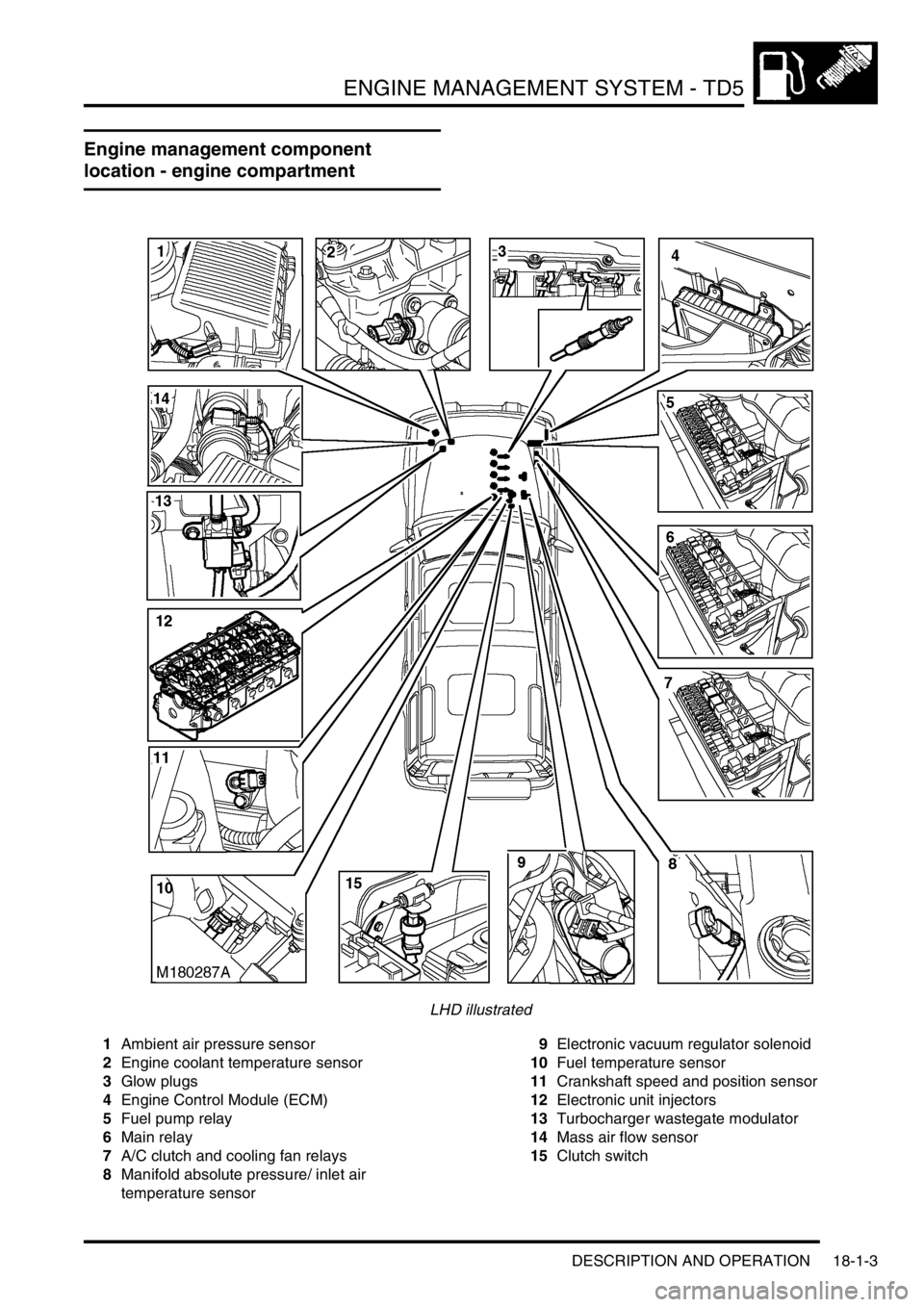
ENGINE MANAGEMENT SYSTEM - TD5
DESCRIPTION AND OPERATION 18-1-3
Engine management component
location - engine compartment
LHD illustrated
1Ambient air pressure sensor
2Engine coolant temperature sensor
3Glow plugs
4Engine Control Module (ECM)
5Fuel pump relay
6Main relay
7A/C clutch and cooling fan relays
8Manifold absolute pressure/ inlet air
temperature sensor9Electronic vacuum regulator solenoid
10Fuel temperature sensor
11Crankshaft speed and position sensor
12Electronic unit injectors
13Turbocharger wastegate modulator
14Mass air flow sensor
15Clutch switch